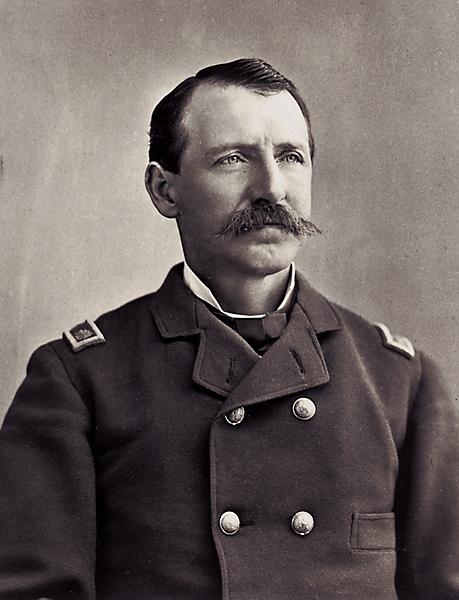Albert Jennings Fountain
Missing since February 1, 1896 from White Sands, Dona Ana County, New Mexico
Classification: Endangered Missing
Vital Statistics
Date Of Birth: October 23, 1838
Age at Time of Disappearance: 57 years old
Circumstances of Disappearance
Albert Jennings Fountain and his eight-year-old son Henry, were last seen in White Sands, New Mexico on February 1, 1896.
According to Wikipedia, "Fountain became a leading figure in the Republican Party in New Mexico, serving a term in the state legislature. Unfortunately, he would acquire numerous political enemies, which probably was the reason behind his mysterious disappearance."
The journey was to take three-to-four days (140 miles) and began in Lincoln, New Mexico, which is in the pass between El Capitan Mountains to the north and Sacramento Mountains to the south. It led southwest, through the Sacramento Mountains to the village of Tularosa. From there, it turned south to the hamlet of La Luz. It then bore southwest for 40 miles southwest across the basin, a desert grass- and shrubland, past the spectacular dunes called White Sands and a gypsum-laced rise called Chalk Hill. It ascended San Augustine Pass, between the Organ and San Augustine Mountains, then descended the western flanks of the mountains, passing through the mining community of Organ. As it drew near the Rio Grande river valley, it passed through Las Cruces and then, home in Mesilla.
Two search parties, one of them led by Fountains son, helped by two Mescalero Apache scouts, "began piecing together the evidence as the sun rose over the Sacramento Mountains, on the eastern horizon. They found where a man had knelt and fired from behind a growth of shrubs, leaving shell casings on the ground. They discovered the site where two men had tended three horses.
They followed wagon tracks and discovered a pool of blood. One man discovered a blood-soaked handkerchief with a nickel and a dime tied carefully in its corner. They followed the wagon tracks of the buckboard and the hoof tracks of six horses east for some 12 miles, into sand dunes west of a small and isolated mountain range called the Jarillas. There, they discovered the carriage, which had been plundered and abandoned. "
Ollie Reed, Jr. of the Albuquerque Tribune in an article on May 25, 2001 refers to the fact that in 1900, charred bones were found in an unmarked grave in the Sacramento Mountains. It is not known if these were the remains of Albert or Henry Fountain.
Investigators
If you have any information concerning this case, please contact: The Doe Network
Source Information:
Colonel Albert Jennings Fountain
Handbook of Texas Online: Albert Jennings Fountain
Murders of Albert Jennings Fountain
Albert Jennings Fountain - Wikipedia
The Doe Network: Case File 3413DMNM
LINK:
http://www.doenetwork.org/cases/3413dmnm.html
Missing since February 1, 1896 from White Sands, Dona Ana County, New Mexico
Classification: Endangered Missing
Vital Statistics
Date Of Birth: October 23, 1838
Age at Time of Disappearance: 57 years old
Circumstances of Disappearance
Albert Jennings Fountain and his eight-year-old son Henry, were last seen in White Sands, New Mexico on February 1, 1896.
According to Wikipedia, "Fountain became a leading figure in the Republican Party in New Mexico, serving a term in the state legislature. Unfortunately, he would acquire numerous political enemies, which probably was the reason behind his mysterious disappearance."
The journey was to take three-to-four days (140 miles) and began in Lincoln, New Mexico, which is in the pass between El Capitan Mountains to the north and Sacramento Mountains to the south. It led southwest, through the Sacramento Mountains to the village of Tularosa. From there, it turned south to the hamlet of La Luz. It then bore southwest for 40 miles southwest across the basin, a desert grass- and shrubland, past the spectacular dunes called White Sands and a gypsum-laced rise called Chalk Hill. It ascended San Augustine Pass, between the Organ and San Augustine Mountains, then descended the western flanks of the mountains, passing through the mining community of Organ. As it drew near the Rio Grande river valley, it passed through Las Cruces and then, home in Mesilla.
Two search parties, one of them led by Fountains son, helped by two Mescalero Apache scouts, "began piecing together the evidence as the sun rose over the Sacramento Mountains, on the eastern horizon. They found where a man had knelt and fired from behind a growth of shrubs, leaving shell casings on the ground. They discovered the site where two men had tended three horses.
They followed wagon tracks and discovered a pool of blood. One man discovered a blood-soaked handkerchief with a nickel and a dime tied carefully in its corner. They followed the wagon tracks of the buckboard and the hoof tracks of six horses east for some 12 miles, into sand dunes west of a small and isolated mountain range called the Jarillas. There, they discovered the carriage, which had been plundered and abandoned. "
Ollie Reed, Jr. of the Albuquerque Tribune in an article on May 25, 2001 refers to the fact that in 1900, charred bones were found in an unmarked grave in the Sacramento Mountains. It is not known if these were the remains of Albert or Henry Fountain.
Investigators
If you have any information concerning this case, please contact: The Doe Network
Source Information:
Colonel Albert Jennings Fountain
Handbook of Texas Online: Albert Jennings Fountain
Murders of Albert Jennings Fountain
Albert Jennings Fountain - Wikipedia
The Doe Network: Case File 3413DMNM
LINK:
http://www.doenetwork.org/cases/3413dmnm.html


